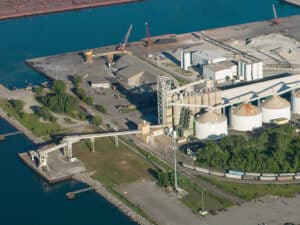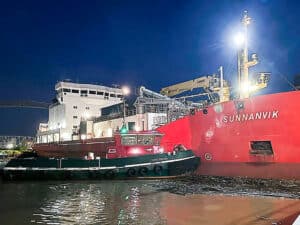![Tom Frazier aground and listing to starboard on Feb. 11, 2024. [Photo: U.S. Coast Guard]](https://www.marinelog.com/wp-content/uploads/2025/06/Towboataground-300x225.jpg)
Poor communication blamed in $1.1 million barge strike on bridge
Written by Nick Blenkey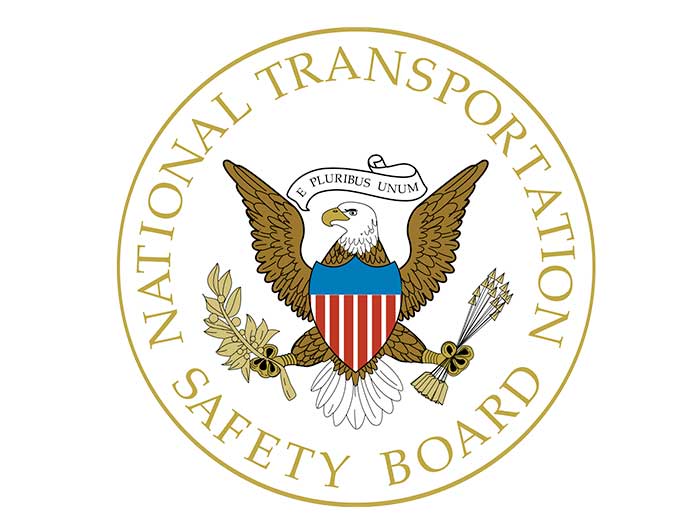
Image: NTSB
The National Transportation Safety Board (NTSB) has issued its report on a January 12, 2021, incident in which an empty hopper barge, pushed by the towing vessel Robert Cenac, struck the CSX Railway Rigolets swing bridge, located about 11 miles southeast of Slidell, La.
No pollution or injuries were reported. However, the bridge sustained damage estimated at $1.1 million, while the barge sustained minor damage estimated at $5,000.
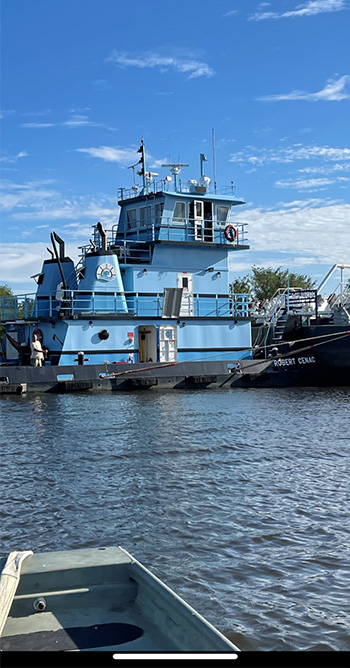
According to the NTSB report, at about 10.31 p.m., near mile 38, the pilot of the Robert Cenac (on watch at that time) informed the Rigolets Bridge operator by radio that the vessel was 30 minutes away inbound and requested the bridge be opened. The pilot recalled the bridge operator as saying there were two trains that had to pass before the bridge could be opened, so the pilot reduced the speed of the tow from about 8 to 4 mph.
At about 22:53 p.m, at Mile 36.5, he steered the tow out of the Gulf Intracoastal Waterway toward the Rigolets Bridge, about 2.4 miles ahead, and then brought the engines to idle. He explained to investigators that “you can’t just sit there a thousand feet away and wait for the bridge to open,” and that the tow should be kept “at least two miles away” to properly line up to pass through the bridge to account for any set from the current and effects of the wind once the bridge was open.
At 11:06 p.m, the Robert Cenac tow was holding about 1.5 miles southeast of the bridge, awaiting further communication from the bridge operator. The pilot noted that the current was setting the tow to the west and he would have to clutch in reverse to keep the tow in a position to line up to pass through the bridge.
While holding, the pilot saw the lights of both trains as they passed over the Rigolets bridge. According to CSX train movement records and signal system data logs, the status of the Rigolets Bridge track circuit changed from “occupied” to “unoccupied” at 11:34 p.m, indicating the rear of the second train was off the bridge.
WATCH HANDOVER
Sometime after 11:30 p.m, the captain of the Robert Cenac arrived in the wheelhouse and began a watch handover. The pilot informed the captain that they were holding and waiting for the bridge operator to call back to announce the bridge was open. Having seen both trains pass, the pilot called the bridge operator over the radio and asked if the bridge was open. The pilot said he heard a reply of “cap, where are you at?” He told the bridge operator, “I’m sitting here waiting on you, about 15 minutes away.” According to the pilot, the bridge operator replied, “I’m gonna get it open for you cap.” After that, around 11.45 p.m., the captain took the helm from the pilot, who went below to the galley. The captain told investigators that, at the time he took the watch, the Robert Cenac was holding, and he was aware that they were waiting for the bridge to open.
Shortly after taking the helm, the captain said that “at some point” he received a call from the bridge operator informing him that the bridge was open. At 11:48 p.m., according to the Robert Cenac’s electronic chart system playback recording, the Robert Cenac began to make headway toward the bridge. Anticipating a westerly set from the current, the captain said he set up against the current, approaching the span at an angle, lining up as he had previously done under similar conditions, “a little to the east.”
He noted that there were “hardly any lights” on the bridge, and he could see only two red lights on the long fender wall. About a half to a quarter mile away, he used the spotlight on top of the wheelhouse to look for the bridge fendering.
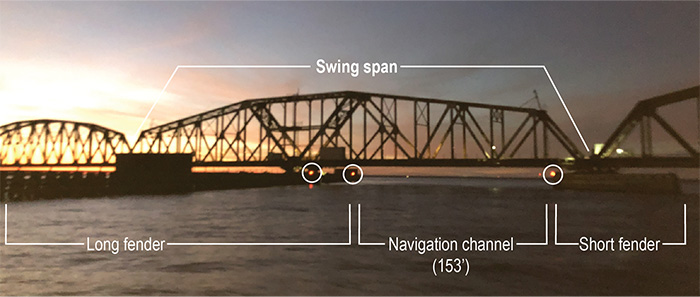
At 11:55 p.m., the head of the tow was about 2,300 feet from the bridge (2,000 feet from the southern end of the long fender), and the tow was moving at a speed over ground of 6.9 mph and a course over ground of 306°. The captain recalled that, with the spotlight pointed toward the head of the barge, he could see the fendering, and he started to line up the tow to pass through the opening. The captain told investigators that, as the tow got closer to the long fender, he saw the swing span was not fully open as he said he had been informed and was overhanging the long fender “looking as if it was three-quarters of the way open.” He told investigators that by the time he noticed the bridge protruding outside of the protective fender and began to back down (full astern), the tow was too close to stop, as the current set the tow toward the span.
NTSB says that investigators determined the bridge operator did not immediately open the bridge after the second train had passed.
Neither the captain nor the bridge operator confirmed the status of the bridge opening with one another. Their accounts of communication surrounding the accident differed. Investigators were not able to confirm the accuracy of the statements as there were no audio recordings or witnesses to the communications.
In addition, investigators found the swing span of the bridge was not fitted with any navigational lighting, as required by regulation, to indicate that it was in the open or closed position nor were navigational lights located at the end of the fenders protecting the bridge piers, also required by regulations.
The NTSB determined the probable cause of the accident was the poor communication between the bridge operator and vessel operator. Contributing to the accident was the absence of bridge span navigational lighting that would have provided the vessel operators with a visual indication of the bridge’s opening status.
“Communication between drawbridge operators and vessel operators requesting bridge opening must be clear,” the report said. “Commonly used in all modes of transportation, closed loop communication, in which the sender confirms the message is understood or provides additional information or clarification, ensures the receiver understands the message.”


